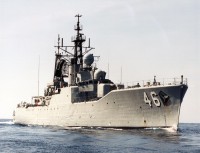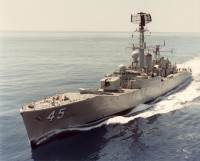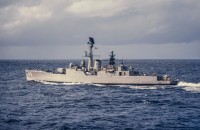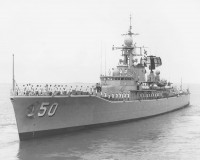River-class destroyer escort
Basic information
Ship measurements
Machine
- 2 * English Electric steam turbines
- 2 * shaft
- 30,000 shp
Personnel
Combat assets
- LW02 long range air warning radar
1979:
- Mulloka sonar system
- SPS-55 surface-search/navigation radar
- Mark 22 fire control radar
- Other system for different units
Type 12M:
- 1 * 2 4.5 inch (113 mm) Mark 6 guns
- 2 * Limbo anti-submarine mortars
Type 12I Batch III:
- 1 * 2 4.5 inch (113 mm) Mark 6 guns
- 1 * quad Seacat SAM launcher
- 1 * Limbo mortar
- 1 * Ikara ASW system
All four of the Type 12M units were refitted with both the Seacat and Ikara missile systems, replacing 40 mm AA guns and Limbo mortars. During refits in the 1980s the Ikara and Seacat systems were removed and 2x Mark 32 triple torpedo launchers were added to all 5 remaining ships (Yarra was scrapped in 1985). Along with this, the 3 newest ships (Derwent, Swan & Torrens) also got mounts for a removable RBS-70 laser guided missile system. (Parramatta and Stuart were due to be decommissioned in 1991, so were not given the RBS-70's as their service life would only be a few more years.)
The River class was a class of six destroyer escorts (originally designated anti-submarine frigates) operated by the Royal Australian Navy (RAN). Plans to acquire four vessels, based on the British Type 12M (or Rothesay class) frigate, began in the 1950s. The first two vessels had some slight modifications to the design, while the next two underwent further changes. Two more ships were ordered in 1964, following the Melbourne-Voyager collision; these were based on the Type 12I (or Leander class) frigate.
By the 1990s, all six ships had left service. Two were sunk as part of tests, and a third was scuttled as an artificial reef, while the other three ships were scrapped.
Design and construction
In August 1950, the Australian government announced plans to acquire a new class of anti-submarine warfare frigates, based on the British Type 12M (or Rothesay class) frigate design. Originally six were planned, with construction to be split between Cockatoo Island Dockyard in Sydney and Williamstown Naval Dockyard in Melbourne, but only four were approved. The first two ships, Parramatta and Yarra, were based directly on the Rothesay class, with changes to fire control system, air warning radar, and habitability to meet RAN operating conditions. The second pair, Stuart and Derwent, were modified to carry a variable-depth sonar over the stern. Although originally classified as frigates, the ships' designation was later changed to destroyer escort.
In 1964, the aircraft carrier Melbourne collided with the destroyer Voyager, resulting in the destroyer's sinking. In order to replace the lost capability, the Australian government ordered another two River-class ships, Swan and Torrens. Unlike the previous four, the new ships were based on the more advanced Type 12I (or Leander class) design.
The ships had a displacement of 2,150 tons at standard load and 2,700 tons at full load. They were 370 ft. (113m) long, had a beam of 41 ft. (12.5m), and a draught of 13 ft. (3.9 m). Propulsion was provided by two double-reduction geared turbines, which supplied 30,000 shaft horsepower (22,000 kW) to two propeller shafts, allowing the vessels to reach 30 knots (56 km/h; 35 mph). Maximum range was 3,400 nautical miles (6,300 km; 3,900 mi) at 12 knots (22 km/h; 14 mph). The ship's company consisted of 250 personnel.
Weapons fit for the first four ships at commissioning consisted of two 4.5 inch Mark 6 guns in a single twin turret, two 40 mm Bofors in a twin mount, and two Limbo anti-submarine mortars. During the 1960s, a quadruple Sea Cat anti-aircraft missile launcher was fitted in place of the Bofors, and one of the Limbo mortars was removed in favour of an Ikara missile launcher. Stuart was the first RAN ship fitted with Ikara, and Derwent the first to carry Sea Cat. In the early 1990s, the missile systems were removed from all active Rivers, with an Army RBS 70 unit available for use if required.
Ships6
- Comments
 en
en ru
ru uk
uk
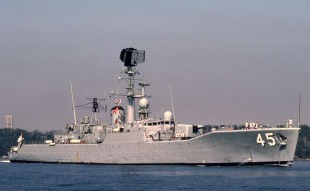
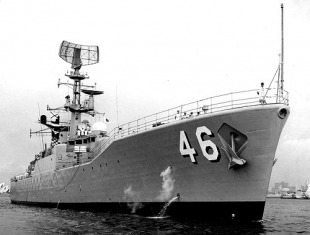
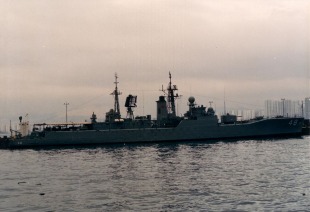
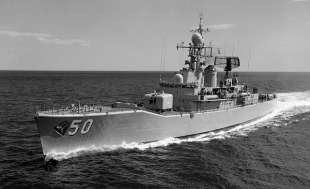
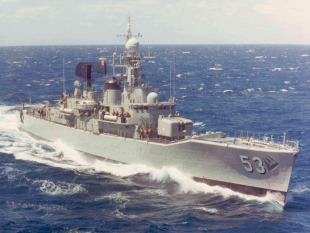
 Royal Australian Navy
Royal Australian Navy